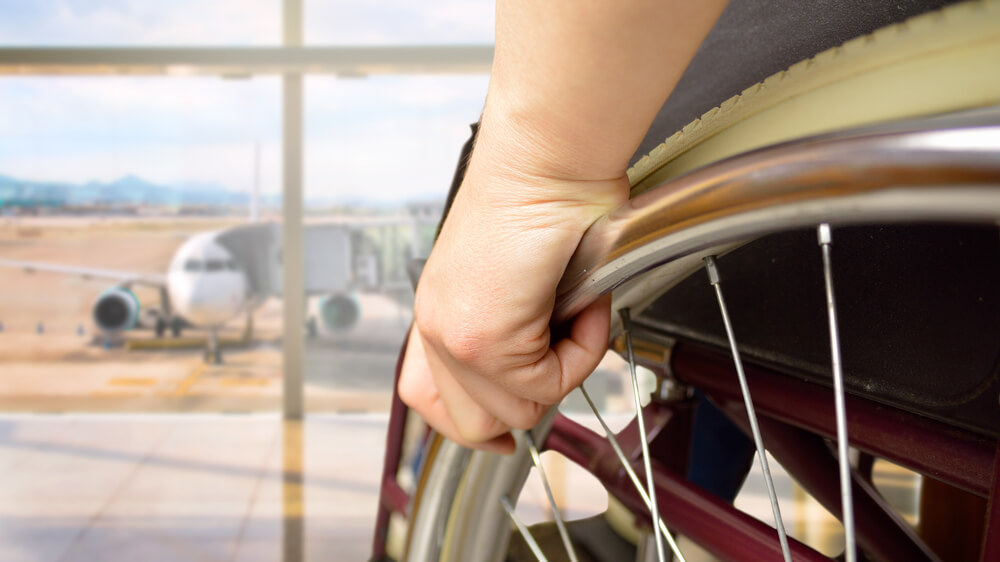When Your Wheelchair is Your Legs: Holding Airlines Accountable For Broken Mobility Equipment
Travel these days gives me a bit more anxiety than it used to. It’s never easy, as I wrote about years ago, and a lot has changed. There’s my usual luggage, and my service dog, Pico. He is truly a joy to fly with as he rests at my feet and naps for the entire flight. There’s my custom-fit wheelchair with power-assist wheels, which took 18 months to obtain through insurance and still left me with several thousand dollars in out-of-pocket costs. Expensive? Sure. However, it’s a small price to pay for independence. So understandably, when I travel, there’s added stress when it comes to the treatment of my wheels by the airline. There are things we can do as wheelchair users to reduce the likelihood of damage, but as with anything in life, there are no guarantees. Traveling is especially stressful for wheelchair users. It’s why many of us avoid flying altogether.
As a wheelchair user, I’m entrusting an airline with the very thing that enables me to move freely throughout my day. Once I’m at the gate, I hope all my carefully articulated instructions are followed and that my chair is handled appropriately. I know some people who are nervous flyers. If they are religious, some will cross themselves to ensure a safe landing. The entire time I’m flying I’m wondering, “Will my ‘legs’ work when we land?” There isn’t enough in-flight entertainment to quell that fear.
When disability advocate and writer Kristen Parisi shared with me her tale of airline travel hell, I was saddened but not surprised. “We landed, and they didn’t know where my chair was,” she recalls. “There was no apology, no acknowledgement of how I must be feeling in this moment. They were more focused on getting me off the plane so the crew could go home. Airlines don’t care. They treat our chairs like they are pieces of luggage. Those are my limbs. I need them to survive and they treat it like trash.”
Parisi reflected that disabled people “are constantly forced to be advocates because society would rather just brush us off and not just deal with it. On the days when you’re just trying to have a vacation you still have to be a constant advocate for yourself.”
While the airline did eventually reunite Parisi with her chair after a two hour delay, data shows it’s a far too common occurrence for wheelchair users. Airlines don’t have the greatest track record with mobility equipment. The only reason we knew this is thanks to Senator Duckworth’s own experience, leading to legislation requiring airlines to report on the frequency of these incidents. (This is yet another reason why representation of disability matters, especially in Congress.)
From January to March 2021, Delta Air Lines handled 15,547 wheelchairs and scooters and reportedly mishandled 103 of those, according to the Air Travel Consumer report. Major airlines combined mishandled 712 or 1.19 percent during that same period, which roughly equates to 23 daily instances where a wheelchair user’s mobility equipment sustained damage. That number may seem small, but it’s still too many. If that many animals were dying as a result of negligence there would be an uproar.
Imagine the airline breaking your legs and saying, “We’re sorry. In the meantime, let’s send you to the hospital and we can fight over the bill later!” That’s essentially what happens when a wheelchair is lost or damaged. It’s not supposed to be that hard, but it is. They’re required by law to cover the cost of damage, repair, or replacement but it’s never that simple in practice.
Our mobility equipment is as unique as we are. Rentals aren’t always feasible and repairs take days, weeks, or months. Suddenly that trip you had planned isn’t happening and you’re stuck in a hotel room unable to move. It’s also likely that airlines are underreporting the actual amount of damage that occurs. The process of filing the multiple reports and providing documentation with persistent follow up can be exhausting, and the last thing any wheelchair user wants on top of damaged equipment is added stress. If your legs are broken, your first thought is dealing with the pain, not bureaucracy. When overwhelm kicks in and you’ve got limited time to follow a regimented process it can be anxiety producing, and with an inability to move, literally paralyzing.
Travel has never been easy for anyone, even prior to the pandemic. As we work to establish our new normal, new stressors are par for the course as we learn to navigate them. There is a lot about the future of travel that remains uncertain. One thing remains clear, however. As thoughts about travel begin to reenter the minds of travelers with mobility equipment, the anxiety that comes with our travel isn’t going anywhere. We need to continue raising awareness, making noise, and holding airlines accountable for their mishandling of our equipment. Travel can bring with it tremendous freedom and joy, provided that nobody takes our ‘legs’ out from under us when we land, but we still have a long way to go.
About Rooted In Rights
Rooted in Rights exists to amplify the perspectives of the disability community. Blog posts and storyteller videos that we publish and content we re-share on social media do not necessarily reflect the opinions or values of Rooted in Rights nor indicate an endorsement of a program or service by Rooted in Rights. We respect and aim to reflect the diversity of opinions and experiences of the disability community. Rooted in Rights seeks to highlight discussions, not direct them. Learn more about Rooted In Rights



